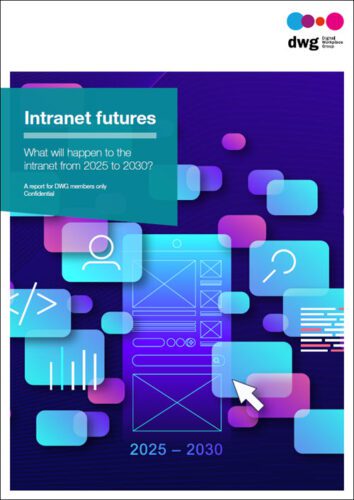Reflections from Nature of Work Live
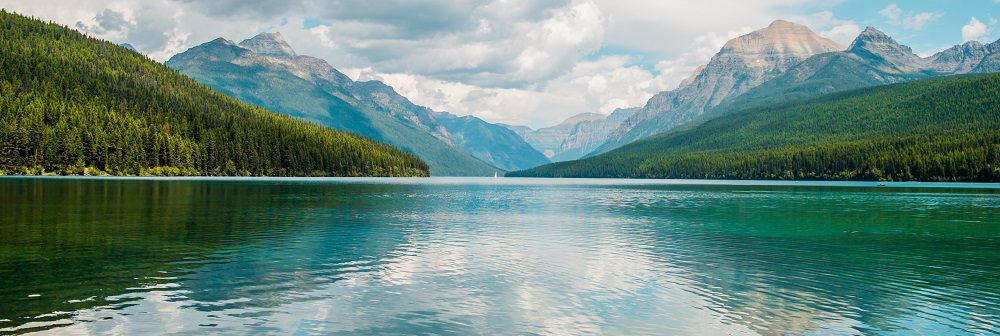
It feels wild to me that just 10 months after the Nature of Work book was published, DWG was able to curate Nature of Work Live. Wild, and also testament to the amazing team we have here that they were able to take the concepts in the book and create an online event, not just in a new format for us all but also a new content area for the team.
Seeing conversations take place about how work can be reimagined amongst such a diverse group of people from across the globe was fantastic to witness, and gives me hope that change is possible. And having globally familiar names, such as LucasFilm, IMF, Adobe, Stella McCartney and Microsoft, listed alongside smaller ones like Cook, WorkWild, Unstitution and ShinyMind also pays tribute to the fact that systemic change needs to be inclusive; everyone has their part to play, and everyone has a role as both mentor and mentee.
Two important streams of thought emerged that particularly excite me to learn more about and understand in relation to how they can enrich Nature of Work: the power of collective imagination and of regenerative practice. The idea that we need to ‘rewild’ our imagination together in shared spaces, and the fantastic practitioners focused on reimagining our systems and behaviours to be regenerative, are both crucial for moving from concept to practice if the living age is to become a reality. Seeing both being introduced to new audiences, such as the Nature of Work community, feels like the start of something transformative.
I have a lot of catching up to do on the breakout sessions I wasn’t able to join, but here are some of my reflections from across our headliners as well as from the breakouts I was in.
We’re all in ‘work drag’
The art of drag is one that has gone mainstream, but it has a long history as a subculture, starting in New York City in the late 19th century, before thriving particularly in the 1980s . The ballroom scene would see people walking different categories in competition for trophies and is where ‘voguing’ was born. It was a place where young queer people of colour could find community and defy society’s gender, sexuality and class norms, find family in ‘Houses’ formed of people who lived together with a ‘Mother’ and/or ‘Father’ often after having to leave their own homes, and where the idea of ‘realness’ – being able to pass in society – was all about safety.
It’s fascinating also to think of drag as not necessarily being exclusively a human artform. If we look to nature, we can see how all sorts of species don drag; there are those for whom demonstrating ‘realness’ means safety (such as the chameleon), and others where drag amplifies who they already are (hello, birds of paradise).
On Hour 2 of Day 3 Nature of Work Live, drag queen Pattie Gonia gave an impassioned talk about her own journey of finding a safety while out in nature that she hadn’t been able to find in society. It was only when in nature that she felt able to don the heels that felt symbolic of who she is, which she hadn’t been able to show amongst her local community.
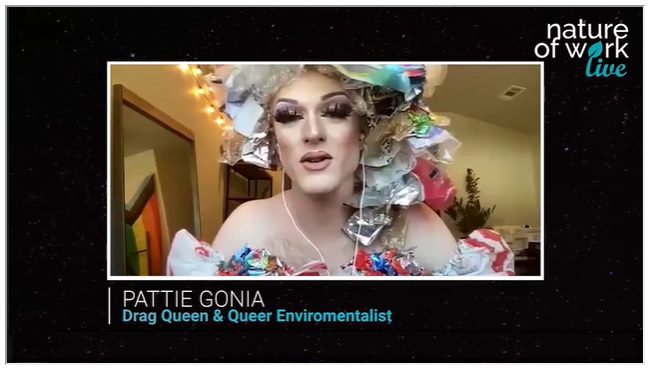
She introduced us to the idea that we are all in ‘work drag’ – something that can be either freeing or restrictive. For many, the option to be their true self at work isn’t an option, often because of environments and cultures in which microaggressions, discrimination and prejudice are all too common. And so, people feel the need to ‘code switch’. They change their language, mannerisms, appearance, and more, in order to fit in; they pursue whichever ‘realness’ their work tells them they need to be, finding safety in work drag. However, for those in work habitats that embrace biodiversity as critical to their organization’s health, work drag can be something celebratory – the ability to wear the ‘boots’ you choose, to amplify and augment all that you are, and where ‘realness’ is about being accepted for who you are both inside and out.
This was a theme that came up in a number of conversations, including that between Sarah Burbedge (BBC) and Lauren Griffiths (HR Consultant), and from Toni Vanwinkle (Adobe), all of them referencing the impact the pandemic has had on how people turn up to work. For many, it’s been an opportunity to ditch their restrictive work personas; for others, there’s still a way to go for true equity to be experienced. A conversation between Annie Parker (Code Club Australia & Techfugees Australia) and Aubrey Blanche (Culture Amp), for example, explored the idea that there is still a lot of ‘unlearning’ to take place. They placed particular focus on start-ups as well as how hard it is for women to gain funding for new ventures when so often those holding the purse strings are white men.
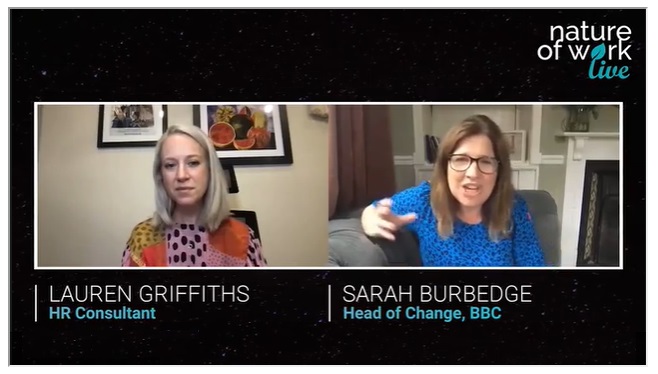
For true biodiversity to flourish in organizations – and within society at large – there is still a lot of ‘rewilding’ that needs to take place. The full richness of the human species can be represented across all levels and industries of work and where ‘work drag’ becomes a celebration.
Regenerative lessons from nature
One of our breakout rooms was called ‘Lessons from Nature’, and it’s a theme we saw emerge in a whole host of conversations across the three days. The scene was beautifully set by Microsoft’s Karlee Scott-Murphy, who was our first headliner, and led us through a powerful visioning exercise located in a healthy forest that in time becomes strangled by an invasive plant species. The analogy could apply to so many areas within work, but for Karlee it was an opportunity to envisage the impact that unhealthy meeting cultures and practices are having.
I also had the privilege of hosting WorkWild’s Founder and Creator, Lucy Colclough, in her workshop on ‘The power of the adaptive cycle’, and also being in conversation with Donna Nelham, a ‘cross-pollinator’, who works with Omnirama, Unstitution and Fractal to build cross-sector coalitions. Both demonstrated the power of learning from nature to reimagine our human systems. From Lucy, we learned how nature’s own adaptive cycle can help us rethink our relationship with change, and how we can move from being shamed by failures to instead seeing them as part of a regenerative cycle. From Donna, we heard about the importance of organizations not seeing themselves as closed systems, but instead honouring their interconnectedness and permeable boundaries with other parts of society and with nature itself.
The need for regeneration at the organizational and systemic levels was also supported by conversations about the importance of regeneration at an individual level. Claire Russell (Mental Health in Business), Poppie Jamie (author, speaker, podcaster), Tegan Creedy and Char Ingle (Happy Space), and Rebecca Howard (Shiny Mind) all tackled the topic of mental health in work, with burnout well documented as being on the rise. It’s important to note here that the workplace can be a cause of low mental wellbeing (for example, through high workloads or unwelcoming environments) as well as harmful to those with clinical mental health diagnoses, and so good mental health requires a combination of individual efficacy with a supportive environment. Hearing from Claire, Poppie, Tegan, Char and Rebecca struck home the importance of viewing rest as a part of work rather than separate from it, and how awareness, educational resources and emotional intelligence all need to be seen as critical skills for individuals, managers and leaders in the workplace.
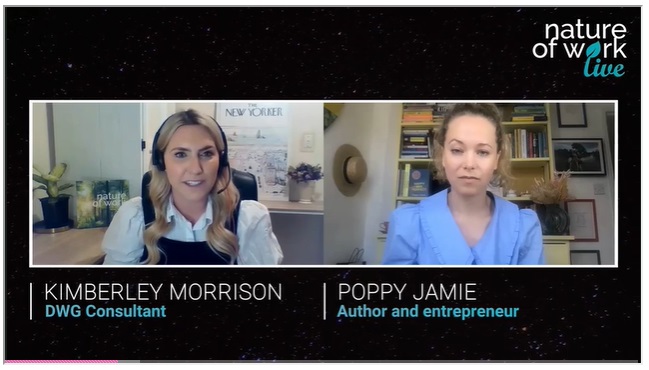
It’s all too easy to see the human species as separate from nature, as opposed to just one part of it. The conversations that brought us ‘Lessons from Nature’ were a welcome reminder that there aren’t many challenges that nature hasn’t itself faced and in turn had solutions emerge; we as individuals and as a collective need the humility and courage to listen to these lessons – and then act.
Creating living work habitats
Another inescapable topic of conversation was where we work, with so many organizations currently trying to work through their ‘hybrid’ work plans for the return to the office.
BT’s Dr Nicola Millard led us through a fantastic journey that started with the ‘zedonk’ – a zebra/donkey hybrid – as a lesson around the need to avoid ‘horrible hybrids’. The promise of hybrid working is one that brings the best of both in-person office work and distributed digital work together in one model. However, with this also comes risk – that it will bring together the worst of both worlds. Avoiding this scenario will take experimentation, adaption, good feedback loops and intentional co-design with employees. Our own research into hybrid work is showing that challenges, such as supporting equity, trust, wellbeing and relationships, will be essential to avoid those ‘horrible hybrids’.

What was also fascinating was hearing Nellie Hayat (Density) and Bryan Emanuel (Raise) in conversation about the role of the workplace in Silicon Valley. While that location has been a rich ground for innovation to thrive, it has also led to harm, for example to local communities excluded from and stripped of resources. Both raised the question of whether it is time for Silicon Valley to become a ‘state of mind’ rather than a specific location, as people start to inhabit shared digital habitats.
Similarly, Dave Cairns (CBRE) and Zoe Ellis-Moore (Spaces to Places) came together in conversation to explore the state of the property industry. There were big questions raised about how this needs to evolve to meet changing preferences and needs around where we work and how commercial space is used; for example, is there an opportunity for empty city buildings to be repurposed to better support local communities and cross-sector collaborations? And Ryan Anderson of Herman Miller (creators of the ‘Living Office’ approach) shared with us his thoughts on how our understanding of workspace needs to shift to become more adaptive and life-centred.
The question of where we are when we’re working is a defining one of the COVID era. Many of these questions aren’t new, but it is the first time they’ve been focused on at such scale and with so much intensity in most of our lifetimes. In order to create meaningful work habitats that span the physical and digital divide, people from across disciplines need not only to come together but to do so with the people who are working in those habitats day-to-day. There is an opportunity to create a new approach to work habitats that benefits the health not only of individuals, but of communities, teams, organizations, society as a whole, and indeed our planet Earth.
Nature of Work Live took place online on November 2-4, 2021, and we will continue to publish articles, podcasts and informal online events throughout 2022 as well. To keep in touch with all things Nature of Work, please sign up to the Nature of Work mailing list.
About the author

Shimrit Janes is Director of Knowledge for DWG, focused on curating knowledge on the digital workplace for its members and clients such as Adobe, The Coca-Cola Company, and Ubisoft.
Shimrit has worked with Paul and DWG colleagues on various initiatives, such as Digital Nations Group, as well as co-hosting the 24-hour global digital experience DWG24. She has had a number of research papers published with DWG on topics such as organizational readiness and collaboration.
Categorised in: → Nature of Work
